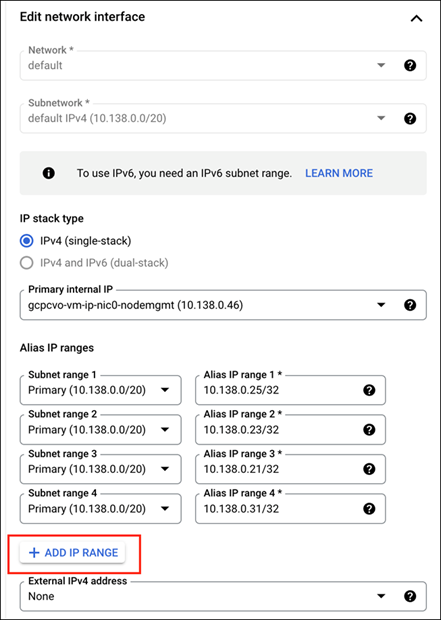Create data-serving storage VMs for Cloud Volumes ONTAP in Google Cloud
 Suggest changes
Suggest changes


A storage VM is a virtual machine running within ONTAP that provides storage and data services to your clients. You might know this as an SVM or a vserver. Cloud Volumes ONTAP is configured with one storage VM by default, but some configurations support additional storage VMs.
Supported number of storage VMs
Multiple storage VMs are supported with specific Cloud Volumes ONTAP configurations in Google Cloud starting with the 9.11.1 release. Go to the Cloud Volumes ONTAP Release Notes to verify the supported number of storage VMs for your version of Cloud Volumes ONTAP.
All other Cloud Volumes ONTAP configurations support one data-serving storage VM and one destination storage VM used for disaster recovery. You can activate the destination storage VM for data access if there's an outage on the source storage VM.
Create a storage VM
If supported by your license, you can create multiple storage VMs on a single node system or on an HA pair. Note that you must use the BlueXP API to create a storage VM on an HA pair, while you can use the CLI or System Manager to create a storage VM on a single node system.
Single node system
These steps create a new storage VM on a single node system using the CLI. One private IP address is required to create a data LIF and another optional private IP address is needed if you want to create a management LIF.
-
In Google Cloud, go to the Cloud Volumes ONTAP instance and add an IP address to nic0 for each LIF.

You need one IP address for a data LIF and another optional IP address if you want to create a management LIF on the storage VM.
-
Create the storage VM and a route to the storage VM.
vserver create -vserver <svm-name> -subtype default -rootvolume <root-volume-name> -rootvolume-security-style unixnetwork route create -destination 0.0.0.0/0 -vserver <svm-name> -gateway <ip-of-gateway-server> -
Create a data LIF by specifying the IP address that you added in Google Cloud.
iSCSInetwork interface create -vserver <svm-name> -home-port e0a -address <iscsi-ip-address> -lif <lif-name> -home-node <name-of-node1> -data-protocol iscsiNFS or SMBnetwork interface create -vserver <svm-name> -lif <lif-name> -role data -data-protocol cifs,nfs -address <nfs-ip-address> -netmask-length <length> -home-node <name-of-node1> -status-admin up -failover-policy disabled -firewall-policy data -home-port e0a -auto-revert true -failover-group Default -
Optional: Create a storage VM management LIF by specifying the IP address that you added in Google Cloud.
network interface create -vserver <svm-name> -lif <lif-name> -role data -data-protocol none -address <svm-mgmt-ip-address> -netmask-length <length> -home-node <name-of-node1> -status-admin up -failover-policy system-defined -firewall-policy mgmt -home-port e0a -auto-revert false -failover-group Default -
Assign one or more aggregates to the storage VM.
vserver add-aggregates -vserver <svm-name> -aggregates <aggr1,aggr2>This step is required because the new storage VM needs access to at least one aggregate before you can create volumes on the storage VM.
HA pair
You must use the BlueXP API to create a storage VM on a Cloud Volumes ONTAP system in Google Cloud. Using the API (and not System Manager or the CLI) is required because BlueXP configures the storage VM with the required LIF services, as well as an iSCSI LIF that's required for outbound SMB/CIFS communication.
Note that BlueXP allocates the required IP addresses in Google Cloud and creates the storage VM with a data LIF for SMB/NFS access and an iSCSI LIF for outbound SMB communication.
The Connector requires specific permissions to create and manage storage VMs for Cloud Volumes ONTAP HA pairs. The required permissions are included in the policies provided by NetApp.
-
Use the following API call to create a storage VM:
POST /occm/api/gcp/ha/working-environments/{WE_ID}/svm/The request body should include the following:
{ "svmName": "myNewSvm1" }
Manage storage VMs on HA pairs
The BlueXP API also supports renaming and deleting storage VMs on HA pairs.
Rename a storage VM
If needed, you can change the name of a storage VM at any time.
-
Use the following API call to rename a storage VM:
PUT /occm/api/gcp/ha/working-environments/{WE_ID}/svmThe request body should include the following:
{ "svmNewName": "newSvmName", "svmName": "oldSvmName" }
Delete a storage VM
If you no longer need a storage VM, you can delete it from Cloud Volumes ONTAP.
-
Use the following API call to delete a storage VM:
DELETE /occm/api/gcp/ha/working-environments/{WE_ID}/svm/{SVM_NAME}


